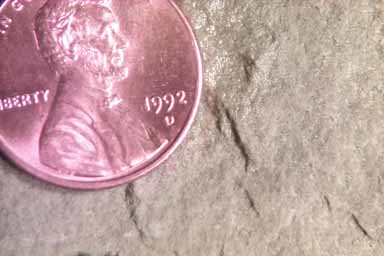igneous rocks
metamorphic
rocks
sedimentary rocks
|
QFL Composition
Silt is a size category of particles below 1/16 millimeter; that is, below visible range. For this reason QFL cannot easily be determined except with a very good microscope. Generally it is ignored.
Description
Silt is a size range of particles between 1/16 mm and 1/256 mm; generally below visible range. At the lower size end it grades into mud (shale), and at the upper size end it grades into sandstone. Often, however, silt and clay are mixed together in varying proportions. Commonly together they form the matrix in a rock, that is the finer material among the larger particles, such as in a wacke sandstone.
This specimen is toward the upper end of the silt size range. It feels very gritty, like a very fine sandstone, or fine sandpaper, yet under the microscope it is difficult or impossible to distinguish the individual grains.
As a practical matter, if the rock is distinctly gritty feeling, but under a handlens or a general laboratory microscope you cannot see the individual particles (they all seem to run together), then the rock is a siltstone.
Tectonic Association
None specific
Semi-quiet depositional environments. Coarse silt is capable of forming cross laminations in a current, while the finer-end particles generally deposit from suspension.
Thus, any depositional environment with these conditions may form silt deposits, and they range from river systems, to deltas, to shelves, to submarine fans and basins. In other words, just about anywhere.
Silt is a common component with other deposits, or is interbedded with other deposits. For example, silt beds are common in flood plain deposits above the point bar sands, and they form the T D unit in a Bouma sequence.
Detail

QFL Composition
Silt is a size category of particles below 1/16 millimeter; that is, below visible range. For this reason QFL cannot easily be determined except with a very good microscope. Generally it is ignored.
Description
Closer view of the larger specimen. If you click the images they will take you into closer and closer views.
This specimen is toward the upper end of the silt size range. It feels very gritty, like a very fine sandstone, or fine sandpaper, yet under the microscope it is difficult or impossible to distinguish the individual grains.
Further Detail

QFL Composition
Silt is a size category of particles below 1/16 millimeter; that is, below visible range. For this reason QFL cannot easily be determined except with a very good microscope. Generally it is ignored.
Description
Closer view of the larger specimen. If you click the images they will take you into closer and closer views.
This specimen is toward the upper end of the silt size range. It feels very gritty, like a very fine sandstone, or fine sandpaper, yet under the microscope it is difficult or impossible to distinguish the individual grains.
|